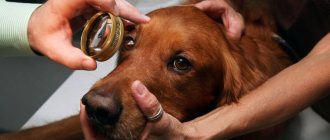What is ataxia in dogs
Ataxia in dogs is not an independent disease, but rather a concomitant symptom of other complex ailments characterized by impaired coordination of the animal’s movements while maintaining the strength of its muscles. The root cause of the disorder is usually damage to the nervous and muscular systems of the dog’s body, which in itself is very dangerous, not to mention the animal’s inability to have normal orientation in space.
Inconsistency in the work of the limbs when walking may well lead to injuries to the paws and fingers, causing additional discomfort to the dog, and head tremors do not allow normal eating and drinking. A sick pet will no longer be able to run, jump and climb stairs as before, and if there is partial or complete paralysis, bedsores may form and the general condition may deteriorate.
Causes of unsteady gait in dogs
There are many reasons that provoke the appearance of a shaky gait in a pet. Especially when it comes to small dog breeds. The main factors of gait disturbance are:
- Mechanical damage. Lameness and problems with gait occur with bruised paws. A dog can get injured when playing excessively with its relatives or with its owner. Upon examination by a doctor, a fracture, ligament rupture, bone cracks, or dislocations may be diagnosed. In this case, the dog partially rests on the injured limb. With brain injuries, the coordination of the animal’s movements is impaired, and unsteadiness of gait is noted. In some severe cases, the animal remains partially paralyzed, dragging its hind limbs.
- Diseases of the central nervous system. Pathologies of the spinal cord often occur due to mechanical damage - compression (squeezing) fractures of the spine, inflammatory processes that provoke swelling, compression of the spinal cord roots and disruption of metabolic processes. Dwarf dog breeds suffer from meningoencephalitis, as a result of which the animal begins to gradually limp on its hind legs, then they fail. The lesion extends to the forelimbs.
- Brain pathologies. Diseases in the area of the brain membranes provoke the appearance of strange movements - walking in circles, chaotic movements around the house. The animal loses coordination and paresis of the limbs is noted. Typical brain lesions for dogs of decorative breeds are hydrocephalus and Chiari syndrome.
- Endocrine pathologies. Problems in the functioning of the endocrine system arise more often due to an incorrect diet and dysfunction of the thyroid gland. Hypothyroidism in a pet provokes the appearance of symptoms such as weakness and refusal of active games. With the disease, damage to the peripheral nervous system often occurs, provoking the development of paresis. An owner with good intentions can feed his pet only meat, which leads to the development of alimentary (nutritional) hypothyroidism. The dog’s bone structures become fragile and actively lose calcium due to metabolic disorders. Such an animal is more often susceptible to bone fractures than its relatives. The dog's diet should be varied and as balanced as possible. It is important to regularly conduct preventive examinations with a veterinarian to ensure timely response in case of pathological changes.
Types of ataxia
Based on the location of the problem, vestibular, cerebellar, sensory, sensitive, frontal and psychogenic types of ataxia in dogs are distinguished. They all have similar symptoms, but at the same time we must not forget about the characteristic differences.
Did you know? Translated from Greek, the name of the disease is understood as “disorder,” since the main manifestation of the disorder is erratic movement of the limbs and loss of body stability.
Vestibular
The vestibular type of ataxia is associated with lesions of the structures of the inner ear or brain stem, which disrupts the normal functioning of the vestibular apparatus as a whole. The main manifestations of such a disorder will be tilting the animal's head to the side, careful slow movements, dizziness and associated nausea. The dog may spin in circles or move chaotically in space.
Cerebellar
As the name suggests, this type of ataxia is associated with damage to the main center of coordination of motor activity - the cerebellum. It coordinates the animal's intentions to perform a specific movement with the further work necessary to successfully complete the process. Cerebellar ataxia manifests itself in dysmetria and symmetrical ataxia of the trunk, due to which the dog tries to spread its paws wide, thus maintaining balance. In rare cases, a tilt of the head and movement of the animal in a circle is noticeable, which is also characteristic of the previous type of ataxia. If you look closely at the eyes, you will hardly be able to notice that your pet’s gaze is fixed on one point - usually the pupils quickly move up and down, and in rare cases they have different sizes on the right and left eyes.
Sometimes a sign of cerebellar ataxia is tremor of the limbs when the pet is moving or at rest. In the first case, the characteristic symptoms of the disorder often appear when the dog tries to reach the intended goal (for example, a bowl of food). Postural tremor, characteristic of a calm state, is expressed in swaying of the body from side to side.
Sensory
Sensory ataxia usually occurs as a result of chronic inflammatory demyelinating polyneuropathy, diabetic polyneuropathy, medical and some other types of neuropathies. Often, such a disorder is caused by disorders associated with heavy metal poisoning, damage to sensitive neural nodes, or spinal cord injury. Disorders in the functioning of the cranial nerves are more likely to cause coordination problems in pets than anything else.
Important! The Romberg test is more often used when diagnosing people, but due to the similarity of the symptoms of the disorder, it may also be appropriate during the examination of an animal. The main thing is that the pet is not afraid of the blindfold and follows the owner’s commands.
Among the main symptoms of sensory ataxia, especially noticeable will be a deep disturbance of sensitivity in the dog’s limbs and damage to the nerves of the spinal cord, which manifests itself in partial or complete paralysis of the animal. A positive result of the Romberg test can also confirm the expected diagnosis: if, standing straight on its paws and closing its eyes, the pet begins to fall to one side, we can talk about the possibility of this problem.
Sensitive
Sensitive or proprioceptive ataxia is equally common in both dogs and cats, but in each case the main causes of this neurological disorder will be:
- intervertebral disc diseases;
- inflammation in the vertebrae and spinal cord;
- oncological processes;
- vestibular ataxia and the disorders that caused it in the form of otitis media, neuritis of the 8th pair of cranial nerves, tumors inside the ear and in the brain stem area.
Like previous types of ataxia, sensitive ataxia is difficult to treat and often turns out to be an irreversible process. True, it all depends on the timeliness of the treatment started.
Frontal
Frontal ataxia is the result of an inflammatory process or mechanical damage to the frontal lobe of the brain, although often the basis for such a disorder is a disruption of the cerebellopontine system. As in other cases, the main manifestations of frontal ataxia will be problems with coordination, tremors of the limbs, and in advanced cases, paralysis.
Did you know? The most famous tall dog in history was the Great Dane named Zeus, who died in 2014 at the age of five. In 2011, he was included in the Guinness Book of Records, because his height at the withers was 1.12 m with a body length of 2.23 m.
Psychogenic
The main manifestation of psychogenic (hysterical) ataxia is considered to be a disturbance in the dog’s gait, which is not a typical sign of organic damage to the nervous system. Sick animals move “along a broken line”, slide their paws as if skating and cross their limbs when walking. Some pets try to walk only on fully straightened legs.
What causes vestibular ataxia in dogs?
As mentioned earlier, the main reason for the development of the disease is heredity, that is, the disease develops when a dog suffering from this disease participated in their mating. Once we have figured out what it is, it is worth discussing other reasons that can trigger the appearance of the disease in a dog. Here are the main ones:
- tumors;
- serious infectious diseases;
- otitis;
- neuritis;
- serious injuries resulting in damage to the animal’s brain.
Symptoms of the disease
When the symptoms of a disease in dogs are mentioned, this is exactly what should be discussed first, because they can identify the disease in the early stages. Let's look at the symptoms that occur most often, here is a list of them:
- constant trembling, as well as noticeable nervousness;
- lack of coordination of movements, which may give the impression that the dog is drunk;
- strange walking, the essence of which is steps of different lengths and constant stops;
- constant falls that occurred, it would seem, on a straight road;
- severe panic in the dog, which is most often expressed in panic attacks;
- the animal’s desire to quickly hide somewhere and not move;
- weakness that becomes more pronounced over time;
- random rotation of the head or, for example, eyeballs;
- lethargy;
- decreased appetite (the amount of food eaten decreases);
- hearing impairment;
- changes in behavior, decreased activity;
- constant head tilt, which was not previously characteristic of a particular dog.
It is not necessary that all the symptoms on this list will appear immediately, since the disease manifests itself in different ways. But if there are at least a few signs, it’s worth showing the animal to a specialist, because even if your fears are not confirmed, the dog will still have some problems. You can find out about them from your veterinarian.
Why is it developing?
Despite the specific type of ataxia in the domestic dog, almost all of its varieties have common underlying causes.
The most common of them include the following:
- neoplasms, injuries and inflammations localized in the spinal cord area;
- infectious processes in the ears and various diseases of the vestibular apparatus;
- infections of the spinal vertebrae or discs;
- viral and infectious diseases affecting the brain stem or any other part of it (for example, plague);
- malignant neoplasms in the dog’s brain;
- deficiency of vitamin B1 in the body;
- metronidazole poisoning;
- decreased levels of calcium and glucose in the animal’s blood;
- problems with blood circulation, in particular caused by cardiovascular diseases;
- respiratory diseases causing complications.
Important! Sometimes the cause of disorders can be a genetic factor, which is why it is so important to buy puppies only from trusted breeders, making sure in advance that their parents have no health problems.
What breeds are predisposed to the disease?
Considering the extensive list of factors influencing the development of ataxia, it can be assumed that such a disorder is relevant for any dog, but, nevertheless, certain breeds are more predisposed to it.
First of all, we are talking about the following dog breeds:
- Cocker Spaniel;
- Chinese Crested;
- Staffordshire Terrier;
- German Shepherd;
- Scotch Terrier;
- Jack Russell Terrier;
- Airedale.
Of course, if you get a pet of one of the listed breeds, this does not mean that you need to prepare for treatment for ataxia. However, increased attention will have to be paid to the health of the animal, providing the dog with the most comfortable living conditions and a balanced diet.
What are the symptoms of ataxia?
The range of symptoms for ataxia can be quite extensive, but not all of them appear at the same time. The sooner the owner notices unwanted manifestations, the greater the chance of maintaining the dog’s mobility and its overall health.
Signs in puppies
The first signs of ataxia usually appear in dogs over the age of two years, but in some cases, impairments in coordination can be noticed after 4–6 months of the animal’s life. One-month-old puppies physiologically cannot keep their balance well, often sitting on their butts or falling over on their sides, but if this does not go away by three or four months and the pet still has poor balance and seems clumsy, it is better to consult a veterinarian. This also applies to those cases when the puppy cannot get its muzzle into the bowl, twisting its neck or body in a strange way.
Did you know? Dogs, just like people, can have a pessimistic or optimistic outlook on life.
Treatment of impaired motor coordination in dogs.
If you are faced with a similar problem, but do not know why the dog is unsteady, you should immediately contact a veterinarian for a full examination. Identifying the cause is critical and may require a range of diagnostic procedures, ranging from ultrasound and x-rays to, in some cases, a CT scan of the brain.
Further treatment is based on the established diagnosis and involves drug elimination of the causes. Unfortunately, in some situations, surgery may be required to solve problems, so if you notice a lack of coordination in your dog, prompt action is very important and will help alleviate the animal’s suffering.
Sudden loss of coordination in dogs is called peripheral vestibular syndrome. It looks scary. A seemingly healthy animal suddenly falls, cannot rise to its feet, and flounders.
Also, drooling, rapid breathing. The dog's head is tilted to the side. The cause of this disease is a disruption of the balance organs. First of all, otitis media can lead to this. Inflammation in the ear can spread to the organ of balance - the labyrinth of the cochlea, and cause a lack of coordination.
The second most common cause of balance disorders is idiopathic vestibular syndrome. More often it affects adult dogs. It goes away on its own after 72 hours - the animal regains the ability to walk, its nausea disappears. But the head tilt may persist for up to two months. There are also congenital hearing abnormalities.
Most often they are found in German shepherds, beagles, and English cocker spaniels. They appear already at 3-4 weeks of age. To a lack of coordination, a cyst or polyps that appear in the inner ear, on the eardrum or eustachian tube.
To diagnose them, you will need otoscopy and cytological analysis. Injury to the temporal bone is also possible. Less commonly, loss of coordination occurs as a result of diseases affecting the brain. This can be toxoplasmosis, canine distemper, cryptococcosis.
How is the diagnosis carried out?
The diagnosis of ataxia is made in dogs based on characteristic clinical symptoms and the results of a neurological examination using additional research methods.
At the initial stages of diagnosis, the main task of the veterinarian is to exclude the presence of metabolic disorders, diseases of the dog’s internal organs, parasitic and infectious diseases that have similar symptoms. For this purpose, blood and urine tests are taken from the animal, and in some clinics they also conduct express tests for viral and parasitic diseases, as well as ultrasound of internal organs.
An equally important assessment criterion is the condition of the pet’s hearing organs. By examining the ears, the doctor can detect damage to the eardrum and external ear canal, and also collect material for cytological examination for bacteria and fungi. Otitis of the middle or inner ear often explains a dog's lack of coordination.
X-rays will help confirm or refute the possibility of skull injury, with the help of which it is possible to detect various neoplasms in the middle ear and establish the presence of internal secretory otitis. MRI and CT are considered a more accurate method of diagnostic examination in this regard, but, unfortunately, not all veterinary clinics have the opportunity to use the appropriate equipment.
Important! MRI is performed under general anesthesia, so before the procedure it is worth doing a cardiogram to make sure there are no problems with the dog’s heart. This is especially true for older animals.
Diagnosis and treatment
To find out the cause of the pathology and establish a diagnosis, the veterinarian examines the animal and collects anamnesis, laboratory tests of blood and urine tests. Diagnostic is the detection of the area of brain damage using MRI.
If ataxia in a dog occurs due to an infectious disease, stroke or lack of vitamins, there is a chance for the dog to be cured after the cause is eliminated. For this purpose, antibacterial drugs, vitamins, immunostimulants and painkillers are prescribed.
Most often, the disease cannot be treated; the specialist suggests carrying out a euthanasia procedure or supporting the life of a weak pet with strong painkillers with appropriate care.
Treatment of ataxia in dogs
The treatment regimen for ataxia in a dog is developed taking into account the characteristics of the root cause of this condition. If the cause of the disorder is any disease, drug therapy can help cope with it, while when diagnosing malignant neoplasms, you will have to resort to surgical intervention with further correction of the condition with chemotherapy. Each method has its own characteristic features.
With the help of drugs
Often, with the help of medications, doctors fight otitis media and other diseases of the ear canal, since these disorders often lead to disturbances in the vestibular function of the body. Depending on the degree of neglect of the condition, antibacterial or even hormonal drugs can be used, some of which are prescribed for systematic use.
Such treatment is also relevant for the development of infectious processes in the spinal cord, and in order to reduce the pain symptom and improve the general condition of the pet, he is prescribed anti-inflammatory and analgesic drugs.
When is the operation performed?
Surgical intervention is appropriate in cases of extensive damage to tissues and organs with the possible formation of malignant or benign neoplasms. The operation also includes drainage of the cavity of the middle or inner ear and bullotomy, which are performed under anesthesia.
Important! In the case of a genetically determined disease, especially if it is severe, it is difficult to completely restore the animal’s normal coordination of movements. In such a situation, it will not be possible to do without physiotherapeutic rehabilitation.
If the detected tumor is localized in the brain, the possibility of surgical intervention is determined taking into account the specific location of the tumor: if it is close to vital brain centers, the operation will be too dangerous and sometimes ineffective. Unfortunately, surgical intervention and further chemotherapy do not always help to completely rid the dog of the existing disorder, saving its life for a long time.
How to properly care for a sick dog
Ataxia is an unusual disease, so the conditions of care will differ from the standard “bed rest”. Often animals continue to remain active, trying to somehow move around the house and outside. To prevent them from harming themselves while moving, it is advisable to arrange a resting place away from sharp corners and heavy objects, and it is better to secure bowls with food and water on stable stands.
If the problem is caused by ear diseases, then, in addition to using tablets and injections, you will have to regularly clean the animal’s ears, removing accumulated exudate. In cases where a pet suffers from paralysis, the owner must make every effort to avoid bedsores: often turn the dog from side to side, rub the back muscles and massage the paws.
Did you know? The Dachshund dog was originally bred to hunt badgers.
The diet of a sick dog should include only easily digestible food: eating scraps from the owner’s table may well lead to disruption of the gastrointestinal tract and add problems to both the dog and its owner.
Reason for violations
Vestibular syndrome is usually divided into 2 large groups: peripheral and central (depending on which part is affected).
Based on the causes, vestibular syndrome is divided into:
- metabolic;
- neoplastic (polyps and neoplasms);
- inflammatory (otitis);
- traumatic;
- toxic;
- idiopathic.
Taking into account these causes of vestibular syndrome, treatment methods also differ.











